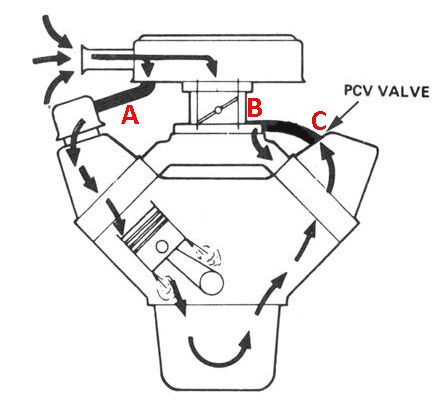How does a PCV valve actually work ??? ( VS. how it's supposed to work.)
So, I know what the function of this valve is and what it's supposed to do.
However, when I inspect the mechanical device it shouldn't seem to work (my explanation below). I also tested it, by blowing through it from the (crankase end)--the valve did not open, as expected from my understanding of the mechanical workings of this device.
I would expect the device to work, if it were seated upside down from its current orientation into the intake manifold.
The device seems to have a plug. With no pressure, gravity would pull the plug into a closed position. Pressure from the crankase would push the plug even deeper into the closed position.
I'll attempt some ASCII sketch.
||| [ ]
[ ]
[ ]
|*| \ /_____________
intake manifold
I would understand how the valve would function, if things were upside down, in that case, pressure--if it was large enough-- from the crankcase would overcome the force of gravity and push the plug upwards into an open position. However, as it is oriented, pressure from the crankcase air and gravity work along the same direction, and will never cancel another out.
Now the above ascii sketch isn't 100% accurate, in reality the valve is seated at about a 45 degree angle, but still with gravity seating the plug in the closed position.
Can someone explain this mystery to me please??
Also, why is there a need for a valve at all?? Why not a straight-thru hose The intake manifold is always vaccuum-like, or below atmospheric pressure (at worst at most at atmosheric pressure when engine is at WOT and low rpm) and the crankcase always is greater or equal to atmospheric pressure; so therefore the flow (if there is a flow at all) would always go from crankcase into the intake manifold; then why is there a need for a valve at all?
What would happen if I replaced the valve with just a hose connection?
So, I know what the function of this valve is and what it's supposed to do.
However, when I inspect the mechanical device it shouldn't seem to work (my explanation below). I also tested it, by blowing through it from the (crankase end)--the valve did not open, as expected from my understanding of the mechanical workings of this device.
I would expect the device to work, if it were seated upside down from its current orientation into the intake manifold.
The device seems to have a plug. With no pressure, gravity would pull the plug into a closed position. Pressure from the crankase would push the plug even deeper into the closed position.
I'll attempt some ASCII sketch.
||| [ ]
[ ]
[ ]
|*| \ /_____________
intake manifold
I would understand how the valve would function, if things were upside down, in that case, pressure--if it was large enough-- from the crankcase would overcome the force of gravity and push the plug upwards into an open position. However, as it is oriented, pressure from the crankcase air and gravity work along the same direction, and will never cancel another out.
Now the above ascii sketch isn't 100% accurate, in reality the valve is seated at about a 45 degree angle, but still with gravity seating the plug in the closed position.
Can someone explain this mystery to me please??
Also, why is there a need for a valve at all?? Why not a straight-thru hose The intake manifold is always vaccuum-like, or below atmospheric pressure (at worst at most at atmosheric pressure when engine is at WOT and low rpm) and the crankcase always is greater or equal to atmospheric pressure; so therefore the flow (if there is a flow at all) would always go from crankcase into the intake manifold; then why is there a need for a valve at all?
What would happen if I replaced the valve with just a hose connection?




